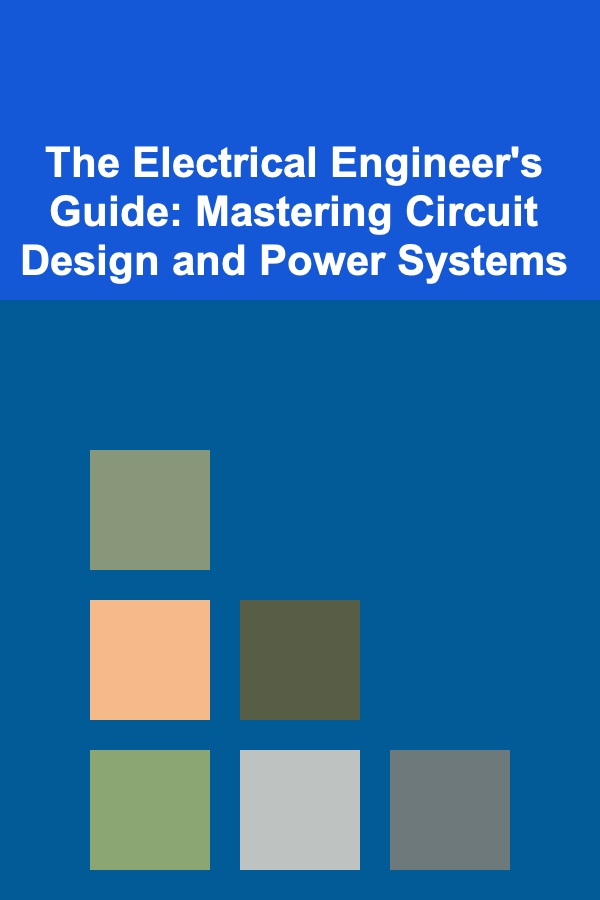
The Electrical Engineer's Guide: Mastering Circuit Design and Power Systems
ebook include PDF & Audio bundle (Micro Guide)
$12.99$6.99
Limited Time Offer! Order within the next:

Electrical engineering is a vast and intricate field that encompasses a variety of sub-disciplines, with circuit design and power systems being among the most fundamental. Mastering these areas requires not only theoretical knowledge but also practical expertise, problem-solving skills, and an understanding of the latest tools and technologies. This guide will delve deeply into the key concepts, strategies, and actionable steps that electrical engineers can employ to master circuit design and power systems, focusing on optimization, efficiency, safety, and innovative practices.
Circuit Design: Principles and Techniques
Circuit design is the backbone of nearly every electrical engineering project, from consumer electronics to large-scale power systems. Effective circuit design focuses on ensuring that components interact in an optimal way to achieve the desired functionality with minimal loss and interference.
Understanding Circuit Theory
Before diving into advanced design techniques, it's essential to understand the core principles of circuit theory. These include Ohm's Law, Kirchhoff's Voltage and Current Laws, and the concepts of impedance, capacitance, and inductance. A solid understanding of these principles will serve as the foundation for any design task.
- Ohm's Law (V = IR): The relationship between voltage (V), current (I), and resistance (R) is fundamental in circuit design. Understanding how these parameters affect circuit behavior helps in choosing appropriate components and adjusting designs to meet specifications.
- Kirchhoff's Laws: Kirchhoff's Current Law (KCL) states that the sum of currents entering a node is equal to the sum of currents leaving. Kirchhoff's Voltage Law (KVL) asserts that the sum of all voltages around a closed loop must be zero. These laws help analyze complex circuits and ensure that the design adheres to electrical constraints.
Actionable Insight:
Start by mastering basic circuit analysis techniques, such as mesh and nodal analysis, to solve complex circuits involving multiple components. Use circuit simulators (e.g., SPICE, LTspice) to test designs before implementation.
Choosing Components
The choice of components plays a crucial role in the design process. Components should be selected based on their performance characteristics, such as voltage, current handling, and power dissipation.
- Resistors, Capacitors, and Inductors: These passive components form the basic building blocks of most circuits. Understanding their behavior in both AC and DC circuits is essential. For instance, capacitors store energy in an electric field and are often used for filtering applications, while inductors store energy in a magnetic field and are used in power supply designs.
- Semiconductors (Diodes, Transistors, FETs): Active components like diodes, transistors, and field-effect transistors (FETs) are critical for switching, amplification, and rectification. In digital circuits, logic gates and flip-flops are essential, while analog circuits might rely on operational amplifiers (op-amps) for signal conditioning.
Actionable Insight:
For efficient component selection, use tools like component databases (e.g., Digi-Key, Mouser) and simulation software to model the performance of different components. Ensure that the components chosen are both cost-effective and meet the performance requirements.
Power Considerations
One of the most important aspects of circuit design is ensuring that power consumption and dissipation are optimized. Overheating and inefficiency can result in system failure or excessive energy costs.
- Power Dissipation: Every component in a circuit generates heat when current flows through it. Power dissipation in resistors is given by P = I²R, while in active components like transistors, it's crucial to consider factors like gain and load conditions.
- Efficiency: For low-power designs, especially in battery-operated devices, reducing power consumption is paramount. Techniques such as voltage scaling, low-power logic design, and power gating can be employed to minimize energy usage.
Actionable Insight:
Always calculate and simulate power dissipation to identify potential overheating issues. Tools like ANSYS Icepak or COMSOL Multiphysics can be used to simulate thermal effects in your circuit design. Additionally, consider using low-power ICs and optimized power management techniques for portable devices.
Layout and PCB Design
Once the components are selected, the next step is the physical design of the circuit, often implemented on a printed circuit board (PCB). The layout of a PCB impacts not just the performance but also the reliability of the circuit.
- Trace Routing and Signal Integrity: Proper trace routing is essential to minimize signal loss, crosstalk, and electromagnetic interference (EMI). High-speed circuits, such as those in RF (radio frequency) applications, require careful design of impedance-controlled traces to ensure signal integrity.
- Power and Ground Planes: A well-designed PCB layout includes solid power and ground planes to reduce noise and improve current distribution. These planes provide low-resistance paths for current flow and prevent ground bounce and voltage fluctuations.
Actionable Insight:
Use advanced PCB design software like Altium Designer or Eagle to optimize the layout of your circuit. Take time to understand the importance of layer stacking and grounding techniques, particularly in high-speed or high-power applications.
Power Systems: Key Concepts and Advanced Strategies
Power systems are the lifeblood of modern infrastructure, ensuring that energy is generated, transmitted, and distributed efficiently and reliably. Designing power systems requires an in-depth understanding of electrical grids, load distribution, fault protection, and system optimization techniques.
Power Generation and Distribution
The generation of electrical power can come from various sources, including fossil fuels, nuclear energy, hydroelectric plants, and renewable energy sources such as solar and wind.
- Centralized vs. Decentralized Generation: Traditional power systems rely on centralized generation, where large power plants distribute electricity across vast distances. However, with the rise of renewable energy, decentralized generation---where small-scale renewable sources are directly integrated into the grid---has become more common.
- Transmission and Distribution: Once power is generated, it must be transmitted efficiently to consumers. High-voltage transmission lines are used to reduce energy loss over long distances. Substations step down the voltage for distribution to homes and businesses. Engineers must consider factors like line loss, voltage drop, and load balancing when designing these systems.
Actionable Insight:
When designing power distribution systems, use simulation tools like PowerWorld, DIgSILENT PowerFactory, or PSS/E to model transmission and distribution networks. These tools allow engineers to analyze voltage stability, load flow, and fault scenarios before implementation.
Power System Optimization
Optimizing power systems involves enhancing performance, minimizing energy loss, and improving the integration of renewable energy sources.
- Load Flow Analysis: Load flow analysis helps engineers assess the power flow throughout the system and ensure that each component operates within its limits. The goal is to optimize the balance between power generation and demand, ensuring a reliable and stable supply of electricity.
- Fault Detection and Protection: Power systems must be designed to detect faults (such as short circuits or equipment failures) quickly and respond to them to prevent damage or widespread outages. Protection systems use relays and circuit breakers to isolate faulty sections of the grid. Modern digital relays offer advanced features like fault diagnosis and remote communication.
Actionable Insight:
Implementing smart grid technologies can improve the overall efficiency and resilience of power systems. Smart grids utilize real-time data to monitor power usage, predict demand, and manage distributed energy resources effectively. Tools like SCADA (Supervisory Control and Data Acquisition) are essential for monitoring and controlling power grids in real-time.
Renewable Energy Integration
Integrating renewable energy sources into the power grid presents unique challenges due to their variable and intermittent nature. Solar, wind, and hydropower are dependent on environmental conditions, which means their power output can fluctuate.
- Grid Stability and Energy Storage: To ensure grid stability, it is essential to incorporate energy storage solutions like batteries and pumped hydro storage. These systems store excess energy during peak production times and release it during periods of high demand or low renewable generation.
- Inverter Design for Solar and Wind: Inverters are critical for converting the DC output from solar panels or wind turbines into the AC power used by the grid. Modern inverters also help regulate the power quality and ensure synchronization with the grid.
Actionable Insight:
When integrating renewable energy into the grid, prioritize energy storage systems and smart inverters. By doing so, you can improve the efficiency and reliability of renewable energy sources. Additionally, consider using hybrid power systems, combining different renewable sources with conventional energy generation for greater reliability.
Safety Considerations in Circuit Design and Power Systems
Safety is paramount in both circuit design and power system operations. Ensuring that the system is safe for both users and equipment requires attention to fault protection, grounding, insulation, and compliance with industry standards.
Fault Detection and Circuit Protection
As discussed earlier, detecting faults promptly is crucial to maintaining safety. In both circuit design and power systems, engineers must implement appropriate protection mechanisms, such as fuses, circuit breakers, and differential protection.
- Grounding and Insulation: Proper grounding is necessary to prevent electric shocks and ensure that excess current is safely diverted to the earth. In power systems, grounding systems must be designed to handle fault currents and protect both equipment and personnel.
- Surge Protection: Lightning strikes and power surges can cause significant damage to electrical systems. Surge protection devices (SPDs) help divert excess voltage away from sensitive components.
Actionable Insight:
Incorporate fault protection mechanisms at all stages of circuit design and power system installation. Make use of modern protective relays and breakers, and ensure compliance with safety standards such as IEC 60364 (Electrical Installations of Buildings) and NFPA 70 (National Electrical Code).
Conclusion
Mastering circuit design and power systems is a multifaceted challenge that requires a deep understanding of both theoretical concepts and practical applications. From optimizing circuit layouts to designing efficient and safe power grids, engineers must continuously apply advanced techniques, utilize simulation tools, and stay updated with industry trends.
By following the principles and actionable insights provided in this guide, electrical engineers can navigate the complexities of circuit design and power systems with confidence, ensuring the creation of efficient, reliable, and safe electrical infrastructures.
Reading More From Our Other Websites
- [Personal Care Tips 101] How to Choose the Best Lip Balm for Your Skin Type
- [Home Staging 101] How to Stage Your Home for a Family-Friendly Vibe
- [Home Rental Property 101] How to Offer Incentives to Attract Quality Tenants
- [Home Budget Decorating 101] How to Decorate Your Home with Cheap but Elegant Accessories
- [Organization Tip 101] How to Create a Designated Space for Stain Removal
- [Home Staging 101] How to Stage a Home with a Home Office to Appeal to Remote Workers
- [Needle Felting Tip 101] Best Approaches to Teaching Needle Felting to Children with Sensory Processing Challenges
- [Home Cleaning 101] How to Organize and Clean Your Office Space at Home
- [Screen Printing Tip 101] Must-Have Tools for Affordable Home Screen-Printing Setups
- [Organization Tip 101] The Best Outdoor Kitchen Layouts for Small and Large Spaces

How to Choose the Right Charity for Your Donations
Read More
How to Make Small Changes in Your Home to Save Big on Monthly Expenses
Read More
How to Make Your Home Smell Like the Holidays with DIY Scents
Read More
How To Understand Small Business Loans and Credit
Read More
How To Explore Deep-Sky Objects with Binoculars
Read More
10 Tips for a Compact and Effective First Aid Kit for Hiking
Read MoreOther Products

How to Choose the Right Charity for Your Donations
Read More
How to Make Small Changes in Your Home to Save Big on Monthly Expenses
Read More
How to Make Your Home Smell Like the Holidays with DIY Scents
Read More
How To Understand Small Business Loans and Credit
Read More
How To Explore Deep-Sky Objects with Binoculars
Read More